Atlantic World > The relationship between the Netherlands and America
- The first salute?
- Joan Derk van der Capellen tot den Pol
- The smouldering revolution
- John Adams in France
- John Adams in Amsterdam
- The Adams boys in Latin School
- The treaty of Friendship and Commerce
- John Adams's eldest son
- John Paul Jones
- John Paul Jones in Holland
The first salute?
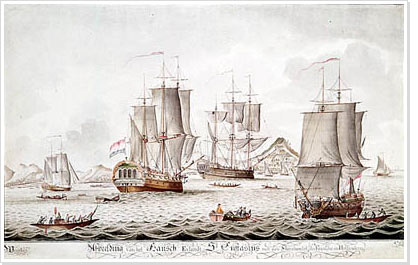 The American naval officer John Paul Jones sailed to France as captain of the Ranger in November 1778. On his arrival on 14 February 1779, he was welcomed with gun salutes in Quiberon Bay by a French admiral's ships.
The American naval officer John Paul Jones sailed to France as captain of the Ranger in November 1778. On his arrival on 14 February 1779, he was welcomed with gun salutes in Quiberon Bay by a French admiral's ships.
This was the first time that the American flag was officially recognized by a foreign power. A comparable event had occurred previously, in November 1776, at St. Eustatius, when the American warship Andrew Doria (sometimes spelled Andrea Doria) sailed into the harbour of the island. In accordance with the international rules of etiquette, captain Robinson lowered the new American flag and greeted the Dutch fort by firing a 13-gun salute. Fort Oranje replied by order of the governor, Johannes de Graaff, with an 11-gun salute. Thus he had in effect recognized the rebellious American states in the name of the Dutch Republic. A major commotion ensued. The fact that the governor had acted on his own authority and not on behalf of the States General of the Netherlands, did not convince the British government. The British were very much offended and the incident was to form one of the immediate causes for the outbreak of the Fourth Anglo-Dutch War (1780 - 1784).
Joan Derk van der Capellen tot den Pol (1741-1784)
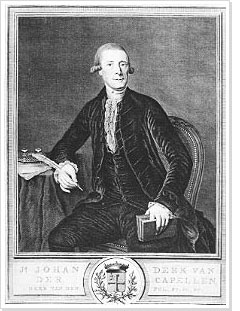 Baron Joan Derk van der Capellen tot den Pol, from the Province of Overijssel, was without doubt one of the most important people in the Dutch Patriot Movement. He described himself as a "born regent", but that did not prevent him from being an ardent champion ot the Enlightenment ideals. As a member of the States of Overijssel he applied himself to the abolition of the so-called 'drostendiensten', which compelled the farmers of Overijssel to labour for a pittance a few days every year for the local magistrate, the Drost (bailiff). This relic from medieval times was wrongfully applied in Van der Capellen's opinion. In an address to the States in 1778, he pointed out that these rights had been officially abolished in 1631. He ensured his statement was distributed widely and free of charge among the farmers in the Twenthe region. In the end he won his case but his fellow members in the States excluded him from particpation in their deliberations until 1782.
Baron Joan Derk van der Capellen tot den Pol, from the Province of Overijssel, was without doubt one of the most important people in the Dutch Patriot Movement. He described himself as a "born regent", but that did not prevent him from being an ardent champion ot the Enlightenment ideals. As a member of the States of Overijssel he applied himself to the abolition of the so-called 'drostendiensten', which compelled the farmers of Overijssel to labour for a pittance a few days every year for the local magistrate, the Drost (bailiff). This relic from medieval times was wrongfully applied in Van der Capellen's opinion. In an address to the States in 1778, he pointed out that these rights had been officially abolished in 1631. He ensured his statement was distributed widely and free of charge among the farmers in the Twenthe region. In the end he won his case but his fellow members in the States excluded him from particpation in their deliberations until 1782.
Previously, he had fallen foul of the Stadholder and the members of the States when he proclaimed himself against expansion of the army and the fleet. When in 1776 the British King asked the Dutch whether he could borrow the Scotch Brigade (a unit of mercenaries in Dutch service) to be deployed in the war with the American Republic, he voted against.
His overt support for the American revolutionaries was not appreciated either. Nevertheless, he continued to dedicate himself to the American War of Independence. He regarded the American struggle as an example for Dutch Patriots. To lend support to his views he translated Observations on civil liberty by the American Richard Price into Dutch. The book was an important inspiration to the American revolutionaries. The Dutch translation was banned in 1789, together with other patriot writings.
In 1780 Van der Capellen arranged a loan for the American cause. Eventually an amount of two hundred thousand guilders was raised. He contributed twenty thousand guilders himself.
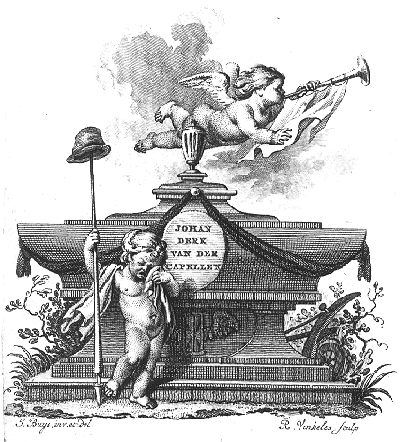 The year 1781 was to be the most important in his political career. In that year a pamphlet appeared entitled "Aan het Volk van Nederland" ("To the People of the Netherlands"). In this anonymous pamphlet the disadvantages of the hereditary stadholderate were explained. It should be replaced by a democratic society, based on popular sovereignty. Within a month after publication the pamphlet was banned. Besides, a substantial reward was offered to whoever would report the author. In spite of these measures it was illegally reprinted and distributed three times, and even translated into French, English and German. It was to exert a lasting influence on the democratic movement in the Netherlands.
The year 1781 was to be the most important in his political career. In that year a pamphlet appeared entitled "Aan het Volk van Nederland" ("To the People of the Netherlands"). In this anonymous pamphlet the disadvantages of the hereditary stadholderate were explained. It should be replaced by a democratic society, based on popular sovereignty. Within a month after publication the pamphlet was banned. Besides, a substantial reward was offered to whoever would report the author. In spite of these measures it was illegally reprinted and distributed three times, and even translated into French, English and German. It was to exert a lasting influence on the democratic movement in the Netherlands.
Van der Capellen, the author of the pamphlet, was forced to enjoy its success in silence, as well as the fact that the authorities failed to identify him as the author. With unflagging zeal he continued to propagate the American cause. Partly thanks to his influence, John Adams and with him the young American Republic were recognized in 1782 by the States General.
He died in 1784. Even after his death he continued to rouse the emotions. A few years after he died his monument was blown up by Orangists.
De smouldering revolution
 In the second half of the eighteenth century the political landscape in the Netherlands was changing slowly but steadily. The two-centuries-old political system of the Republic, with its specific roles for the States General, the Pensionary of State and the Stadholder (the Prince of Holland), was starting to crack.
In the second half of the eighteenth century the political landscape in the Netherlands was changing slowly but steadily. The two-centuries-old political system of the Republic, with its specific roles for the States General, the Pensionary of State and the Stadholder (the Prince of Holland), was starting to crack.
Influenced by the Enlightenment, a movement came into being that wanted to put an end to the power of the Stadholder and the regents. Instead, representatives of the citizenry were to form the decisive political power. The supporters of this movement called themselves Patriots. Their opponents were known as Orangists, or sometimes as 'Kezen'.
The Patriot movement did not have a clear and univocal political programme that was shared by all Patriots. The result was that groups of reformist Patriots got together all over the country with the objective to change, each in their own way, the existing political set-up. Nevertheless, in 1786 there were some successful attempts in a number of Dutch towns to dislodge the sitting regents from their seats with the help of Patriot militias. This caused major political tension and a civil war threatened to break out between Patriots and Orangists. The unrest eroded the stadholder's authority and he took refuge in Nijmegen.
When Wilhelmina, the wife of stadholder Willem V, set out in 1787 to stir the Orangists in The Hague into action against the Patriots, something unprecedented happened. She was stopped by Patriots at Goejanverwellesluis. It was the ultimate insult to the stadholder's authority. Wilhelmina's brother, the king of Prussia, in September of the same year sent 20.000 troups to restore order in the Republic with the stadholder's consent.
The Patriot militias were shoved aside without difficulty by the Prussian grenadiers, the stadholder's authority was restored and thousands of Patriots fled the country. They went to revolutionary France where they applied for political asylum. They were to stay there for years. Not until 1795 they returned to the Netherlands, accompanied by French troups.
John Adams (1735-1826) in France
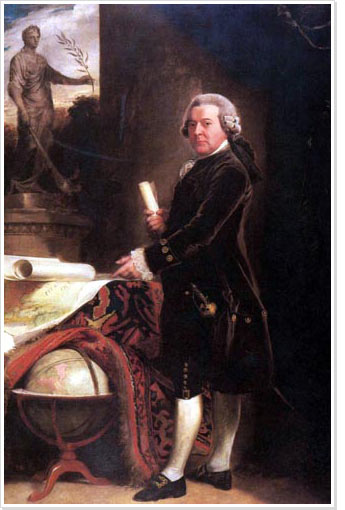 In 1776 the American War of Independence broke out. John Adams was involved from the beginning in a prominent role. The American colonists were supported by France in their war against Great Britain. It was of great importance to the young American republic to retain, and if possible increase, the support of the French. To this end a delegation of American diplomats was sent to Paris. John Adams arrived there in 1778.
In 1776 the American War of Independence broke out. John Adams was involved from the beginning in a prominent role. The American colonists were supported by France in their war against Great Britain. It was of great importance to the young American republic to retain, and if possible increase, the support of the French. To this end a delegation of American diplomats was sent to Paris. John Adams arrived there in 1778.
In Paris he met with Benjamin Franklin who was also entrusted with the task of acquiring more support. Adams and Franklin disagreed on the form this support should take. Adams was of the opinion that the United States should not depend exclusively on French assistance. Such a position would give France too much influence on American policy. Adams was not the only one to hold these views. Some Congressmen had already proposed to investigate the option of doing business with the Dutch. Even before the French, the Dutch had been smuggling arms, ammunition and other goods to the rebels. Especially Dutch merchants made a good deal of money out of the American struggle. It was not unlikely that these merchants would be eager to provide a loan to the young nation. On the longer term this could make them even more money.
The American Congress decided after long consideration to entrust Henry Laurens with the negotiations with the Dutch. It would take a while, though, before he could reach Europe. In the meantime, in Paris, tensions were mounting between Franklin and Adams, who did not want to wait for Laurens's arrival. After a heavy argument Adams left for the Netherlands to investigate: "whether something might be done to render us less dependant on France".
He arrived with his two sons in the summer of 1780 in the most important town of the Republic.
John Adams in Amsterdam
 In Amsterdam, Adams and his sons initially stayed in the simple lodging house of Madame La Veuve du Henry Schorn on the Achterburgwal near the Hoogstraat. From here he worked almost daily on building a network of Amsterdam bankers and merchants.
In Amsterdam, Adams and his sons initially stayed in the simple lodging house of Madame La Veuve du Henry Schorn on the Achterburgwal near the Hoogstraat. From here he worked almost daily on building a network of Amsterdam bankers and merchants.
He had mixed feelings about the workings of Dutch politics. To his foreign minister, John Jay, he wrote: "I have been in the most curious country among the most incomprehensible people and under the most singular constitution of government in the world". On the endless consultations that preceded every decision he remarked: "The councils of this people are the most inscrutable I ever saw."
For the Dutch Patriots he also had little praise. He thought them not very well-read and certainly badly informed about international developments. On the other hand he thought that in comparison with all other European countries the best information was to be obtained in the Netherlands.
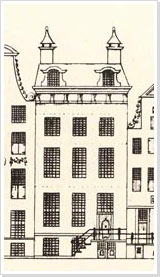 In October 1780 Adams learned that Henry Laurens was detained at sea by the British while on his way to Europe. He had quickly thrown his papers overboard but they did not sink fast enough and the British had fished them out. Among his papers was the draft for a secret agreement between the US and the Netherlands. The discovery of these papers caused major embarassment to the Dutch and it would constitute the 'casus belli' for yet another war with Great Britain.The immediate outcome of Laurens' arrest was that responsibility for acquiring a loan of ten million dollars was transfered to Adams. He understood that he now had to ensure that his status increased. To silence the bankers and end any derogatory talk about his simple lodgings with the widow, in the summer of 1781 he took a lease on a house on Keizersgracht 529.
In October 1780 Adams learned that Henry Laurens was detained at sea by the British while on his way to Europe. He had quickly thrown his papers overboard but they did not sink fast enough and the British had fished them out. Among his papers was the draft for a secret agreement between the US and the Netherlands. The discovery of these papers caused major embarassment to the Dutch and it would constitute the 'casus belli' for yet another war with Great Britain.The immediate outcome of Laurens' arrest was that responsibility for acquiring a loan of ten million dollars was transfered to Adams. He understood that he now had to ensure that his status increased. To silence the bankers and end any derogatory talk about his simple lodgings with the widow, in the summer of 1781 he took a lease on a house on Keizersgracht 529.
The house was built around 1760 and the exterior is still largely in the original state. Only the eighteenth century chimneys have disappeared from the roof (see the drawing by Caspar Philips).
The Adams boys in Latin School
 Two of the existing Latin Schools in Amsterdam were joined together in 1666 in the former Aalmoezeniershuis (almhouse) on Singel 451-457. In 1897 the premises were rebuilt and acquired their current dimensions. A number of years ago the building was renovated again. Not much is left of the old Aalmoezeniershuis, only the archway can be identified, incorporated in the modernized facade.
Two of the existing Latin Schools in Amsterdam were joined together in 1666 in the former Aalmoezeniershuis (almhouse) on Singel 451-457. In 1897 the premises were rebuilt and acquired their current dimensions. A number of years ago the building was renovated again. Not much is left of the old Aalmoezeniershuis, only the archway can be identified, incorporated in the modernized facade.
Two of John Adams's sons, John Quincy and his younger brother Charles, went to the Latin School in 1780. Their stay was of short duration. The two brothers did not settle in, partly because they did not speak Dutch. When a teacher threatened to punish one of the children because he felt the boy was not trying, Adams took both boys out of school. He arranged for them to be privately taught in Leiden and to follow lectures at the local university.
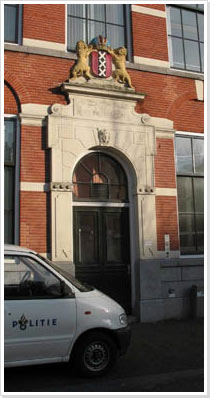
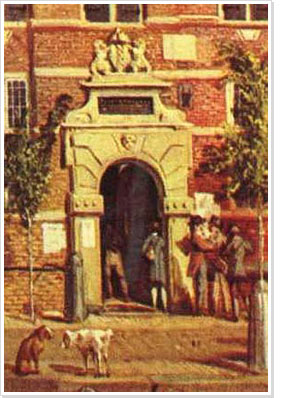
The treaty of Friendship and Commerce
 A large part of the year 1780 John Adams devoted to building a network of relations in the Netherlands. Politicians, bankers and Patriots could rely on his unremitting attention. The struggle in America did not go as well as Congress would wish and more than ever they were in need of money. Adams noticed that his initial optimism about his chances to acquire a loan was in danger of evaporating. The endless deliberations and the decision making procedures of the Dutch Republic, that were totally incomprehensible to him, started to undermine his confidence. What annoyed him most were the Dutch frugality and greed. He wrote to a friend: "Such a Nation of Idolators at the Shrine of Mammon never existed, I believe". Nevertheless he kept trying, with the help of the Dutch Patriot Baron Joan Derk van der Capellen tot den Pol, to convince the policy makers of the purpose and necessity of a formal relationship with the new American Republic. But the rulers in Amsterdam and The Hague kept tarrying.
A large part of the year 1780 John Adams devoted to building a network of relations in the Netherlands. Politicians, bankers and Patriots could rely on his unremitting attention. The struggle in America did not go as well as Congress would wish and more than ever they were in need of money. Adams noticed that his initial optimism about his chances to acquire a loan was in danger of evaporating. The endless deliberations and the decision making procedures of the Dutch Republic, that were totally incomprehensible to him, started to undermine his confidence. What annoyed him most were the Dutch frugality and greed. He wrote to a friend: "Such a Nation of Idolators at the Shrine of Mammon never existed, I believe". Nevertheless he kept trying, with the help of the Dutch Patriot Baron Joan Derk van der Capellen tot den Pol, to convince the policy makers of the purpose and necessity of a formal relationship with the new American Republic. But the rulers in Amsterdam and The Hague kept tarrying.
A fresh approach
In the spring of 1781 Adams decided on a completely new approach. He chose an unorthodox method. Contrary to protocol, on 19 April 1781 he wrote a sixteen page letter to the States General proposing that the two countries enter into a treaty. He suggested in his letter that such a treaty would result in profitable trade relations and considerable financial gain for the Netherlands. The document was translated into English, French and Dutch with the help of his Dutch friends and distributed as a pamphlet in many thousands of copies among the supporters of the American cause. Now all they could do was wait.
Setback
When an answer remained forthcoming, John Adams became seriously ill. In all probability he had contracted malaria in his Amsterdam canalside house and it took months before he had more or less recovered. All these setbacks had worn him out, which hampered his recovery. The struggle in America did not go as desired in the summer of 1781. The Americans lost the important port of Charleston to the British and general Gates suffered a crushing defeat near Camden. The treason of the American general Benedict Arnold was an additional setback. In view of these circumstances many of his Dutch contacts did not want to have anything more to do with him. Besides, the British ambassador, Joseph Yorke, was putting pressure on the Netherlands by threatening with war. This threat was to become a reality at the end of the same year.
The tide is turning
Then, finally, there is some good news. On 23 November 1781 the news reached Adams that the British had been defeated near Yorktown. The British general Cornwallis surrendered his army, which in effect put an end to the American War of Independence. Shortly after, John Adams ventured to press the States General for a reply to his earlier request. The time had come to let go of the prudence that for such a long time had characterised Dutch diplomacy. In The Hague it was no longer considered likely that the British would be able to recover militarily. When the States of Friesland were the first to proclaim themselves in favour of recognition, Adams bought a large house on Fluwelen Burgwal in The Hague, in anticipation of further official arrangements. This was to become the first embassy in American history.
Success!
The important province of Holland voted in March 1782 for the proposed recognition, the other provinces followed suit. On 19 April, a year after he had made his request and six years after the American Declaration of Independence, John Adams was officially acknowledged as ambassador. This made the Republic, after France, the second country to enter into formal relations with the young American nation.
This did not mean that the requested loan was all settled now as well. That did not happen until Tuesday 8 October 1782, when Adams, in the Trèves Room on Binnenhof (the seat of government), was able to conclude a loan of 5 million guilders (2 million dollars), at 5% interest. This was not the 10 million dollars Congress had asked for, but all parties were nevertheless content. The commission that John Adams had taken upon himself, had finally succeeded.
John Adams's eldest son
 John Quincy Adams was born in 1767 in Braintree, Massachusetts. His father John Adams and his wife Abigail took strict care that from childhood the children prepared themselves for their future duties in the service of their country. Without doubt, John Quincy was the more talented of their sons. To him Adams wrote in a letter: "You will ever remember that all the end of study is to make you a good man and a useful citizen."
John Quincy Adams was born in 1767 in Braintree, Massachusetts. His father John Adams and his wife Abigail took strict care that from childhood the children prepared themselves for their future duties in the service of their country. Without doubt, John Quincy was the more talented of their sons. To him Adams wrote in a letter: "You will ever remember that all the end of study is to make you a good man and a useful citizen."
To France
When Adams was appointed to Paris, John Quincy went with him. In France he learned to speak French fluently. When he moved to Amsterdam together with his father, his younger brother Charles joined them. After a short period at the Latin School in Amsterdam John Quincy and Charles departed for Leiden. There they were educated privately and went to university.
To Russia
At the age of fourteen, John Quincy travelled with Francis Dana, a friend of his father, to the court of the Russian tsar in Saint Petersburg. There he worked as a secretary and translator for the American delegation. At that time, French was still an important language of diplomacy, spoken at various European courts.
On his way to the presidency
In 1785 he returned to the United States to finish his law degree at Harvard University. He had only just started to practice law in Boston, when president George Washington asked him to serve as ambassador to the Netherlands (like his father before him). John Quincy was ambassador from 1794 until 1797. This was to be the beginning of a long and successful diplomatic career, which finally brought him (again just like his father) to the highest position. This happened in 1825 when he was nominated as the 6e President of the United States. His presidency was not a great success and he was not re-elected after he finished his first term. A year later he returned to Capitol Hill, this time as an elected member of Congress.
The Amistad affair
In 1841 he was involved as a lawyer in the court case regarding the slave ship Amistad. Adams was not an abolitionist, but in the case that the owners had brought against the release of the rebellious slaves he nevertheless pleaded for their right to self-determination and freedom. Finally the case was won before the Supreme Court and the surviving Africans could return to Africa.
During a debate in the House of Congress he suddenly collapsed from a heart attack. Two days later, on 23 February 1848, he died.
John Paul Jones
 Jones's career
Jones's career
John Paul was born in Scotland, on 6 July 1747. At the age of thirteen he went to sea where he learnt the sailor's profession in practice. When he was 21 years old, he was already captain of a merchantman. He settled in the American state of Virginia where he added the part of 'Jones' to his name. When the War of Independence broke out, he joint the rebels. As captain of the Ranger he sailed to France in November 1778.
Jones in the North Sea
Immediately after his arrival, the French supplied Jones with additional provisions and an extra ship. Jones named this ship Bon Homme Richard. On 14 August 1799 he departed with a small fleet with the aim to attack British ships in their own territorial waters.
After nearly one month he engaged in battle with the much stronger British man-of-war H.M.S. Serapis. A bloody encounter ensued with the ships incessantly firing their guns at each other. It seemed that Jones was to taste defeat and the British captain called out to him to concede. John Paul Jones replied in his characteristic manner: " I have not yet begun to fight!" An hour later roles were reversed and the Serapis lowered her flag. The next day the Bon Homme Richard sank. Jones and his crew were forced to go aboard the captured Serapis.
John Paul Jones in Holland
 Run aground at Texel
Run aground at Texel
On 3 October 1779, John Paul Jones sailed into the harbour of Texel with a squadron consisting of American and captured British warships. The event caused great political excitement in the Netherlands and in Great Britain. As soon as the British Navy learned that Jones had taken refuge in the harbour of the island of Texel, they blocked the harbour with their fleet. The British ambassador in The Hague, Joseph Yorke, put pressure on the States General to return the British ships or to expel the Americans.
Jones used his forced stay in the Netherlands for a kind of public relations tour. He went to Amsterdam where he received a warm welcome from both regents and citizens. Thus it became clear to see for everyone where the Dutch sympathies were. And it made clear as well that the problem would not easily be solved.
In the meantime, the States General did what they always did in times of crisis: they met and deliberated in committees on how to deal with this problem. After much debate the States General on 12 November sent a Dutch navy squadron to Texel. Its orders were to force the Americans to leave. Jones understood that he would have to act fast, as he had little room left for manoeuvring. He brought his ships, with the exception of the Alliance, under the French flag. As a result of this trick the ships could not be handed over to the British. Time was short though, and it was with the greatest effort that Jones got an additional reprieve from the Dutch commander. This extra time he used to prepare the Alliance for a breakout.
Breakout!
When on 27 December the British squadron that was blocking the harbour was scattered by a heavy storm, Jones crept out of Texel harbour. The British discovered just a fraction too late that he had escaped. It was too late to set off in pursuit. Jones tried again to attack and capture British ships in the Channel, but failed. After some more wanderings he put in at a French port.
